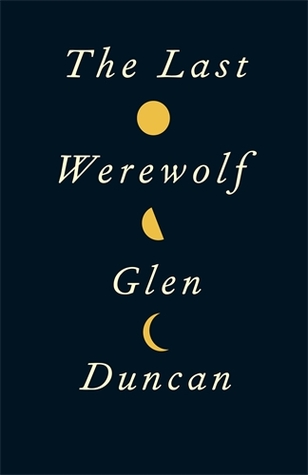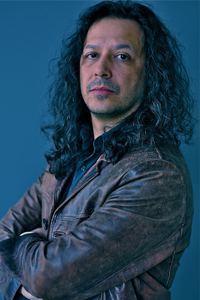Short Fuse Commentary: The Skillful Supernaturalism of Glen Duncan
Here you have it: Werewolves are horny, vamps merely thirsty. This, to be sure, is material to work with, as novelist Glen Duncan does. But I can’t help thinking about great nineteenth-century novels of involuntary transformation.
The Last Werewolf by Glen Duncan. Knopf, 293 pages, $25.95.
By Harvey Blume.
I picked up Glen Duncan’s The Last Werewolf (2011) from the new fiction shelf at the library a month or so ago because I was looking for a good read and remembered that I had found Duncan’s I, Lucifer (2003) enchanting.
The plot of I, Lucifer concerns the aches and pains, the trials,
tribulations and daily humiliations, visited on the title character—Him—by HIM. The details of plot mattered less to me in retrospect than the fact that the writing was so fine. I’m tempted to say, at this remove, that Duncan managed to make Lucifer—drug fiend and sex addict though he was—more Chaplinesque than Miltonic, more schlemiel than Satan, in prose as pin point as the sentences Martin Amis used to chisel back in the day.
On the strength of I, Lucifer I rushed to pick up Duncan’s next book, Death Of An Ordinary Man, and was disappointed. It was labored, the plot a melodramatic look back on life by some dead guy, the prose an exhausting pursuit of brilliance.
I’m glad I gave Duncan a third chance. The Last Werewolf is sharp and savory. Maybe the story of an ordinary man just didn’t whet Duncan’s appetite, bring out his literary lusts, as the plight of supernatural beings do. Jake Marlowe, the main character and narrator of The Last Werewolf, while not on the A list with Lucifer, commands no lack of anguished, lupine charm. Marlowe—he knows his Raymond Chandler—is a werewolf with a conscience, disgusted by the things he must do on a monthly basis when the full moon visits the wracking Hunger upon him. Call it meta-disgust, if you will, because he’s disgusted, as well, that disgust doesn’t stop him.
The Last Werewolf is less the story of Jake prowling than of him being hunted. Agents of Wocop (World Organization for the Control of Occult Phenomena) have recently beheaded what they think is the penultimate werewolf and are now out in force for Jake, hoping to rid the world of his kind for good. They are opposed, however, by an upstart faction that wants to breed werewolves, treat them as an endangered species, and release them into the wild, as desired: to hunt the werewolf being a chase like no other. Besides the agents of Wocop Jake must face yet another foe.
From vampires, of course.
At this point I need to draw back and ask why the theme of vampires v. werewolves has suffused today’s media—from high to low, from English satire a la Duncan to Disney channel shows in which your average, academically stunted teen can tell you as much about the vamp/wolf rivalry as a Civil War buff can about Bull Run. And I am simplifying things by keeping the ever proliferating zombie hordes out of the equation.
What is this about? If you have a hunch, do tell. (Let us crowd source this matter. The views of vamps and wolves will be considered, those of zombies for now not.)
Wocop, with its internal divisions, vamps with kinky designs on wolves, a wolf narrator divided against himself: there are times the plot is like a pileup on some highway of the weird and the reader reduced to rubber necking. What kept me going through those bottlenecks is that Jake Marlowe, despite decades on the planet, has a contemporary sensibility. When things overwhelm him he opines,
Something else was going on. (Whatever is happening, as the late
Susan Sontag noted, something else is always going on. It’s
literature’s job to honor it. No wonder no one reads.)
Nice.
And here’s Jake helping Tallulah, a female werewolf not yet on
Wocop’s hit list, understand the vamp/wolf rivalry. She says,
“I know this is crazy, but I can’t quite get over the whole vampire
thing. That they really exist.”
[This is funny coming from a werewolf, no?]
[Jake]: “It’s the lameness of their having to sleep during the day.
That and the not having sex.”
[Tallulah] “They don’t?”
“They don’t. The desire goes. I mean, they’ll tell you screwing’s
nothing to draining a victim but that’s always sounded desperate to
me. It’s one of the reasons they hate us.”
Here you have it: Werewolves are horny, vamps only thirsty. This, to be sure, is material to work with, as Duncan does. But I can’t help thinking about great nineteenth-century novels of involuntary transformation, such as Robert Louis Stevenson’s The Strange Case of Dr. Jekyll and Mr. Hyde and Emile Zola’s Bête Humane. Zola and Stevenson (likewise Dostoevsky in The Double) deal with the sorts of terrors you could not explain away by references to a full moon or fang marks on your neck—deep fears, inner aliens, complexities that were far from understood. Are they better understood now?
In his novel Stevenson writes,”I thus drew steadily nearer to that truth. . . that man is not truly one, but truly two. I say two, because the state of my own knowledge does not pass beyond that point. Others will follow, others will outstrip me on the same lines; and I hazard the guess that man will be ultimately known for a mere polity of multifarious, incongruous and independent denizens.”
Duncan does not take us beyond double nature, beyond wolf and man, does not entertain being “multifarious, incongruous.” Perhaps, given all the explanations, from Sigmund Freud to Oliver Sacks, subsequent to Stevenson, it is hard to restore plain awe to his kind of probe into who we are.
Talulla Rising is the just published sequel to The Last Werewolf. Talulla and Jake had their orgiastic moments, as werewolves will. Jake, well, is out of the picture. Talulla bears their. . . cub?
The Last Werewolf was a good read.
I’ll get back to you about Talulla Rising.



I’m way behind on all this. I should start with I, Lucifer — that sounds really good. I seriously wonder whether the devil exists or not — Is he Cartesian like, I sin and I doubt, there I am ?
But you have not increased my interest in werewolves and vampires — still get a zero reading on that gauge.
fred
i’m not trying to increase yr interest in wolves & vamps. i’m not on the payroll, don’t own shares. but i will say they’re pretty unavoidable, these days, whether you turn on the tube or pick up a book.
perhaps you have an organic spray of some sort to expel them from our minds?
harvey
hey bill i know that, being ed., you have to moderate this and hence are a kind of captive audience.
ed. this!
you’ve sd that hg wells’s “the island of dr. moreau” belongs alongside what i’ve called “great nineteenth-century novels of involuntary transformation” — stevenson’s “the strange case of dr. jekyll and mr. hyde” and zola’s “bête humane”.
i know the wells from the movie (charles laughton). the book may be a very different thing.
still, in the wells the agent of horrific transformation is not unknown. in the novels i cite, it remains mysterious.
this may be a distinction without sufficient difference, but worth noting.
Hi Harvey,
Wells’ The Island of Doctor Moreau is, among other things, a diabolical satire of Darwin — the mad scientist’s accelerated transformation of animals into amoral faux-humans is accomplished via vivisection. His ability to create his talking animal/ people is as mysterious as the formula that Jekyll creates and drinks to release his inner beast. (Evolution does not run smooth or in explicable directions.) Science enables the iconoclastic fantasy … gives permission to turn the world upside down in nightmarish ways.
Read the book — it is a very different animal than the movie (more political and seamy), though the Laughton version is 90 great minutes in the “House of Pain.”
“the island of doctor moreau” may be worth revisiting, though anti-darwinism is not my thing. “the island. . . ” always made me think of circe, which in turn reminds me that the theme of transformation/ metamorphosis goes way back, & only recently seems to have become stuck on the broken record of vamps & wolves.
The allusion to Greek myth is there all right — and The Island of Doctor Moreau is a dark parody of Darwin, not an attack, with religion, colonialism, and capitalistic exploitation among the others targets.
but now, contra circe, zeus & hg wells, i come to the thought that when it comes to transformation, we’re down to vamps & wolves. (i really don’t want to discuss zombies despite having met a few in my time.)
All the great nineteenth century novels about “two-natured” characters seem to focus on men. Women at that time were either one or the other. Either angels or demons, either Jane Eyre or Mr. Rodchester’s mad wife in the attic, never both in the same body. There are indeed many two-natured female types in folklore and mythology, but apparently Victorian novelists had a hard time imagining such a thing. Or perhaps there are examples of two-natured women in nineteenth century literature that I’m not aware of.
interesting. bram stoker’s dracula does create, obviously derivative, female vamps. english lit. does have “la belle dame sans merci”. she does go back and forth from monster to damsel. i believe there is more of that sort of thing in german lit., though i don’t know first hand.
and what about fairy tales?
pat sherman — in person! — makes an interesting point about how the fairy/witch of “la belle dame sans merci” is unlike the main characters of “the strange case of dr. jekyll and mr. hyde” and of “la bête humane”.
the human aspect — & physical beauty — of “la belle dame” are nothing more than masks for her demonic nature, about which keats leaves no doubt. not so with the main characters of the stevenson and the zola: they are genuinely torn between warring aspects of themselves, between murderousness and morality. if they are demonic, they are also, equally, human. that is what torments them.
seems to me that they are modern in a way “la belle dame” is not. they look forward to psychology and neurology. she looks backward to superstition.
of course, she is a creature of male imagination: an enchantress & destroyer. . . lilith etc.